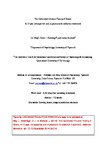The Elaborated Intrusion Theory of Desire: A 10-year retrospective and implications for addiction treatments
| dc.contributor.author | May, Jon | |
| dc.contributor.author | Kavanagh, DJ | |
| dc.contributor.author | Andrade, Jackie | |
| dc.date.accessioned | 2014-09-30T09:43:03Z | |
| dc.date.accessioned | 2014-09-30T09:43:28Z | |
| dc.date.available | 2014-09-30T09:43:03Z | |
| dc.date.available | 2014-09-30T09:43:28Z | |
| dc.date.issued | 2014-09-22 | |
| dc.identifier.issn | 0306-4603 | |
| dc.identifier.issn | 1873-6327 | |
| dc.identifier.uri | http://hdl.handle.net/10026.1/3127 | |
| dc.description.abstract |
Ten years after the publication of Elaborated Intrusion (EI) Theory, there is now substantial research into its key predictions. The distinction between intrusive thoughts, which are driven by automatic processes, and their elaboration, involving controlled processing, is well established. Desires for both addictive substances and other desired targets are typically marked by imagery, especially when they are intense. Attention training strategies such as body scanning reduce intrusive thoughts, while concurrent tasks that introduce competing sensory information interfere with elaboration, especially if they compete for the same limited-capacity working memory resources. EI Theory has spawned new assessment instruments that are performing strongly and offer the ability to more clearly delineate craving from correlated processes. It has also inspired new approaches to treatment. In particular, training people to use vivid sensory imagery for functional goals holds promise as an intervention for substance misuse, since it is likely to both sustain motivation and moderate craving. | |
| dc.format.extent | 29-34 | |
| dc.format.medium | Print-Electronic | |
| dc.language | en | |
| dc.language.iso | en | |
| dc.publisher | Elsevier BV | |
| dc.relation.replaces | http://hdl.handle.net/10026.1/3126 | |
| dc.relation.replaces | 10026.1/3126 | |
| dc.subject | Craving | |
| dc.subject | desire | |
| dc.subject | imagery | |
| dc.subject | addiction treatment | |
| dc.title | The Elaborated Intrusion Theory of Desire: A 10-year retrospective and implications for addiction treatments | |
| dc.type | journal-article | |
| dc.type | Article | |
| plymouth.author-url | https://www.webofscience.com/api/gateway?GWVersion=2&SrcApp=PARTNER_APP&SrcAuth=LinksAMR&KeyUT=WOS:000351645100006&DestLinkType=FullRecord&DestApp=ALL_WOS&UsrCustomerID=11bb513d99f797142bcfeffcc58ea008 | |
| plymouth.volume | 44 | |
| plymouth.publication-status | Accepted | |
| plymouth.journal | Addictive Behaviors | |
| dc.identifier.doi | 10.1016/j.addbeh.2014.09.016 | |
| plymouth.organisational-group | /Plymouth | |
| plymouth.organisational-group | /Plymouth/Admin Group - REF | |
| plymouth.organisational-group | /Plymouth/Admin Group - REF/REF Admin Group - FoH | |
| plymouth.organisational-group | /Plymouth/Faculty of Health | |
| plymouth.organisational-group | /Plymouth/Faculty of Health/School of Psychology | |
| plymouth.organisational-group | /Plymouth/REF 2021 Researchers by UoA | |
| plymouth.organisational-group | /Plymouth/REF 2021 Researchers by UoA/UoA04 Psychology, Psychiatry and Neuroscience | |
| plymouth.organisational-group | /Plymouth/REF 2021 Researchers by UoA/UoA04 Psychology, Psychiatry and Neuroscience/UoA04 REF peer reviewers | |
| plymouth.organisational-group | /Plymouth/Research Groups | |
| plymouth.organisational-group | /Plymouth/Research Groups/Centre for Brain, Cognition and Behaviour (CBCB) | |
| plymouth.organisational-group | /Plymouth/Research Groups/Centre for Brain, Cognition and Behaviour (CBCB)/Behaviour | |
| plymouth.organisational-group | /Plymouth/Research Groups/Centre for Brain, Cognition and Behaviour (CBCB)/Cognition | |
| plymouth.organisational-group | /Plymouth/Research Groups/Institute of Health and Community | |
| plymouth.organisational-group | /Plymouth/Research Groups/Plymouth Institute of Health and Care Research (PIHR) | |
| plymouth.organisational-group | /Plymouth/Users by role | |
| plymouth.organisational-group | /Plymouth/Users by role/Academics | |
| dc.publisher.place | England | |
| dcterms.dateAccepted | 2014-09-15 | |
| dc.identifier.eissn | 1873-6327 | |
| dc.rights.embargoperiod | Not known | |
| rioxxterms.versionofrecord | 10.1016/j.addbeh.2014.09.016 | |
| rioxxterms.licenseref.uri | http://www.rioxx.net/licenses/all-rights-reserved | |
| rioxxterms.type | Journal Article/Review |


